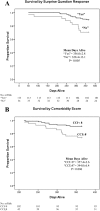Utility of the "surprise" question to identify dialysis patients with high mortality
- PMID: 18596118
- PMCID: PMC2518805
- DOI: 10.2215/CJN.00940208
Utility of the "surprise" question to identify dialysis patients with high mortality
Abstract
Background and objectives: Dialysis patients are increasingly characterized by older age, multiple comorbidities, and shortened life expectancy. This study investigated whether the "surprise" question, "Would I be surprised if this patient died in the next year?" identifies patients who are at high risk for early mortality.
Design, setting, participants, & measurements: This prospective cohort study of 147 patients in three hemodialysis dialysis units classified patients into "yes" and "no" groups on the basis of the "surprise" question response and tracked patient status (alive or dead) at 12 mo. Demographics, Charlson Comorbidity Index score, and Karnofsky Performance Status score were measured.
Results: Initially, 34 (23%) patients were classified in the "no" group. Compared with the 113 patients in the "yes" group, the patients in the "no" group were older (72.5 +/- 12.8 versus 64.5 +/- 14.9), had a higher comorbidity score (7.1 +/- 2.3 versus 5.8 +/- 2.1), and had a lower performance status score (69.7 +/- 17.1 versus 81.6 +/- 15.8). At 12 mo, 22 (15%) patients had died; the mortality rate for the "no" group was 29.4% and for the "yes" group was 10.6%. The odds of dying within 1 yr for the patients in the "no" group were 3.5 times higher than for patients in the "yes" group, (odds ratio 3.507, 95% CI 1.356 to 9.067, P = 0.01).
Conclusions: The "surprise" question is effective in identifying sicker dialysis patients who have a high risk for early mortality and should receive priority for palliative care interventions.
Figures

Similar articles
-
Predicting 12-month mortality for peritoneal dialysis patients using the "surprise" question.Perit Dial Int. 2013 Jan-Feb;33(1):60-6. doi: 10.3747/pdi.2011.00204. Epub 2012 Aug 1. Perit Dial Int. 2013. PMID: 22855890 Free PMC article.
-
Nephrology Provider Prognostic Perceptions and Care Delivered to Older Adults with Advanced Kidney Disease.Clin J Am Soc Nephrol. 2017 Nov 7;12(11):1762-1770. doi: 10.2215/CJN.03830417. Epub 2017 Sep 18. Clin J Am Soc Nephrol. 2017. PMID: 28923833 Free PMC article.
-
Reliability and Utility of the Surprise Question in CKD Stages 4 to 5.Am J Kidney Dis. 2017 Jul;70(1):93-101. doi: 10.1053/j.ajkd.2016.11.025. Epub 2017 Feb 15. Am J Kidney Dis. 2017. PMID: 28215946 Free PMC article.
-
Charlson Comorbidity Index is a predictor of outcomes in incident hemodialysis patients and correlates with phase angle and hospitalization.Int J Artif Organs. 2004 Apr;27(4):330-6. doi: 10.1177/039139880402700409. Int J Artif Organs. 2004. PMID: 15163067
-
Dialysis Modality and Mortality in the Elderly: A Meta-Analysis.Clin J Am Soc Nephrol. 2015 Jun 5;10(6):983-93. doi: 10.2215/CJN.05160514. Epub 2015 May 4. Clin J Am Soc Nephrol. 2015. PMID: 25941194 Free PMC article. Review.
Cited by
-
Executive summary of the KDIGO Controversies Conference on Supportive Care in Chronic Kidney Disease: developing a roadmap to improving quality care.Kidney Int. 2015 Sep;88(3):447-59. doi: 10.1038/ki.2015.110. Epub 2015 Apr 29. Kidney Int. 2015. PMID: 25923985
-
"Should I go on dialysis, Doc?": initiating dialysis in elderly patients with end-stage renal disease.Can Fam Physician. 2012 Dec;58(12):1353-6, e704-7. Can Fam Physician. 2012. PMID: 23242893 Free PMC article. No abstract available.
-
Predicting six-month mortality for patients who are on maintenance hemodialysis.Clin J Am Soc Nephrol. 2010 Jan;5(1):72-9. doi: 10.2215/CJN.03860609. Epub 2009 Dec 3. Clin J Am Soc Nephrol. 2010. PMID: 19965531 Free PMC article.
-
Prioritizing Primary Care Patients for a Communication Intervention Using the "Surprise Question": a Prospective Cohort Study.J Gen Intern Med. 2019 Aug;34(8):1467-1474. doi: 10.1007/s11606-019-05094-4. Epub 2019 Jun 12. J Gen Intern Med. 2019. PMID: 31190257 Free PMC article.
-
Palliative dialysis: a change of perspective.J Clin Med Res. 2014 Aug;6(4):234-8. doi: 10.14740/jocmr1773w. Epub 2014 May 22. J Clin Med Res. 2014. PMID: 24883146 Free PMC article. Review.
References
-
- Moss AH. Kidney failure. In: Palliative Care: Core Skills and Clinical Competencies, edited by Emanuel LL, Librach SL, Philadelphia, Saunders Elsevier,2007. , pp355 –369
-
- US Renal Data System: USRDS 2006 Annual Report: Atlas of End-Stage Renal Disease in the United States, Bethesda, National Institutes of Health, National Institute of Diabetes and Digestive and Kidney Diseases,2006. , p136
-
- Cohen LM, Germain MJ, Woods AL, Mirot A, Burleson JA: The family perspective of ESRD deaths. Am J Kidney Dis 45 :154 –161,2005 - PubMed
-
- Cohen LM, Germain M, Poppel DM, Woods A, Kjellstrand CM: Dialysis discontinuation and palliative care. Am J Kidney Dis 36 :140 –144,2000 - PubMed
-
- Chambers EJ, Germain M, Brown E, eds. Supportive Care for the Renal Patient, Oxford, Oxford University Press,2004
Publication types
MeSH terms
LinkOut - more resources
Full Text Sources
Medical

